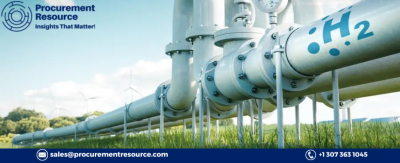Hydrogen, often termed the fuel of the future, is rapidly gaining attention for its role in advancing clean energy initiatives. As global demand for sustainable solutions rises, understanding hydrogen production costs becomes crucial for businesses and policymakers. Hydrogen plays an essential role in sectors like transportation, power generation, chemical processing, and even residential heating, where it offers a low-carbon alternative to conventional fossil fuels. Here, we explore the primary factors impacting hydrogen production costs, different production methods, and how data-driven cost reports can help industries optimize their investment in this promising fuel source.
Request a Free Sample for Hydrogen Production Cost Reports – https://www.procurementresource.com/production-cost-report-store/hydrogen/request-sample
Why Hydrogen is Crucial for a Sustainable Future
Hydrogen (H₂) is the most abundant element in the universe, but it rarely exists in its pure form on Earth. For hydrogen to be useful, it must be separated from other elements, such as oxygen in water, or carbon in natural gas. Due to its versatility, hydrogen is a critical component in producing clean energy. It’s used as a fuel for fuel cells in transportation, an energy source in power plants, and a reducing agent in the steel industry. Hydrogen is also central to achieving global climate goals, as it can reduce greenhouse gas emissions when produced sustainably.
Given its potential, companies across various sectors are investing in hydrogen technology. However, the cost of hydrogen production is a major factor in determining its viability as a mainstream energy source. Accurate, real-time data on production costs is essential for businesses to strategize and allocate resources effectively.
Key Factors Influencing Hydrogen Production Costs
Hydrogen production costs vary significantly depending on the production method, regional energy prices, and technological advancements. Here’s a closer look at the primary factors driving hydrogen production costs:
1. Production Methods and Feedstock Costs
The method used to produce hydrogen largely determines the cost structure. The three main methods for hydrogen production include:
Read the Full Report – https://www.procurementresource.com/production-cost-report-store/hydrogen
-
Steam Methane Reforming (SMR): SMR is the most common method of hydrogen production, using natural gas as the primary feedstock. While it’s cost-effective, it also emits carbon dioxide, which requires additional carbon capture technology to reduce emissions. The cost of natural gas plays a significant role in determining SMR-based hydrogen costs, making it sensitive to global natural gas price fluctuations.
-
Electrolysis: Electrolysis involves splitting water into hydrogen and oxygen using electricity. When powered by renewable energy sources, it produces green hydrogen without emissions. However, electrolysis is energy-intensive, making electricity prices the dominant factor in its production cost. As renewable energy prices decrease, the cost of green hydrogen from electrolysis becomes more competitive.
-
Biomass Gasification and Other Renewable Sources: Hydrogen can also be produced from biomass, such as agricultural waste, which offers a renewable alternative. However, the initial investment and processing costs for biomass gasification are relatively high, making it a more costly method than SMR or electrolysis.
2. Energy Costs
Hydrogen production is energy-intensive, particularly for methods like electrolysis that rely on high volumes of electricity. The availability and cost of energy play a crucial role in determining hydrogen production costs. Regions with access to affordable renewable energy sources, like solar or wind power, have a cost advantage in producing green hydrogen. Conversely, in areas where electricity costs are high, electrolysis becomes less competitive, affecting the overall hydrogen market.
3. Capital Expenditure and Operational Costs
Capital expenditure (CAPEX) refers to the initial costs required to set up hydrogen production plants, including the equipment, technology, and infrastructure needed. Operational costs (OPEX), on the other hand, cover ongoing expenses such as labor, maintenance, and utilities. Advanced technologies, such as high-efficiency electrolyzers or carbon capture systems in SMR, come with higher CAPEX but can reduce OPEX over time by improving energy efficiency and reducing emissions.
4. Environmental and Regulatory Costs
With governments increasingly supporting low-carbon initiatives, environmental regulations and policies are impacting hydrogen production costs. To encourage clean hydrogen production, many countries offer incentives or subsidies for renewable-based hydrogen projects. However, compliance with environmental regulations, such as carbon taxes on traditional hydrogen production methods, can also drive up costs. The cost of implementing carbon capture and storage (CCS) for SMR-produced hydrogen, for instance, adds to the production cost but is often necessary to meet regulatory requirements.
5. Technological Advances and Scalability
Technological advancements in hydrogen production have the potential to reduce costs significantly. Innovations such as high-efficiency electrolyzers, improved catalyst materials, and digital monitoring systems for production plants help lower energy consumption and increase output. Additionally, as hydrogen technology scales up and more production facilities are developed, economies of scale are expected to reduce costs, making hydrogen more accessible for widespread use.
Analyzing Hydrogen Production Costs with Cost Reports
For companies and investors interested in hydrogen, gaining a clear understanding of production costs is essential to staying competitive. Hydrogen Production Cost Reports provide a comprehensive breakdown of every aspect influencing production costs, enabling stakeholders to make informed decisions.
Ask an Analyst – https://www.procurementresource.com/production-cost-report-store/hydrogen/ask-an-analyst
Benefits of Hydrogen Production Cost Reports
-
Detailed Cost Breakdown: Cost reports cover each factor impacting production, from raw materials and energy costs to capital investment and environmental expenses. This level of detail allows companies to identify which costs can be optimized and where they may be able to reduce expenses.
-
Up-to-Date Data and Forecasts: The hydrogen market is rapidly evolving. Real-time data on production costs and forecasts enables stakeholders to anticipate future cost trends, helping them stay proactive in a competitive landscape.
-
Benchmarking and Industry Comparison: Cost reports provide insights into industry benchmarks, allowing companies to compare their costs with competitors. By identifying areas where they exceed or lag behind industry standards, companies can make adjustments to improve efficiency and reduce expenses.
-
Procurement Strategies: Effective procurement strategies are crucial for controlling feedstock and energy costs. With insights into cost trends, companies can establish long-term contracts for raw materials or energy, stabilizing production costs and mitigating volatility.
-
Environmental Compliance and Carbon Footprint Analysis: Hydrogen production cost reports include information on environmental regulations and the costs associated with compliance. This helps companies evaluate their carbon footprint and determine whether additional investment in carbon capture or other technologies is necessary.
How Procurement Resource Can Support Your Hydrogen Production Strategy
At Procurement Resource, we specialize in delivering comprehensive Hydrogen Production Cost Reports tailored to industry needs. Our reports go beyond raw data, providing actionable insights into global cost drivers, emerging trends, and best practices in hydrogen production.
What You Can Expect from Our Hydrogen Production Cost Reports:
-
In-Depth Analysis of Production Methods: From SMR and electrolysis to emerging methods like biomass gasification, our reports offer a detailed comparison of costs across production techniques, helping you select the most efficient method for your goals.
-
Real-Time Data and Price Forecasts: Our team of analysts provides current market data and projections for hydrogen production costs. By staying informed on price trends, you can optimize purchasing strategies and align your budget with industry forecasts.
-
Comprehensive Cost Structure Breakdown: Understand the full spectrum of costs, including raw materials, energy, labor, capital expenditures, and regulatory compliance, so you can pinpoint areas to streamline operations.
-
Benchmarking and Market Positioning: We provide industry benchmarks that allow you to measure your production costs against those of competitors, helping you identify opportunities for improvement and cost reduction.
-
Customized Solutions and Expert Insights: Our hydrogen cost reports are customizable, tailored to meet the specific needs of your business. Our analysts offer expert insights and practical strategies for optimizing production costs, reducing emissions, and navigating regulatory complexities.
Stay Ahead in the Hydrogen Economy with Procurement Resource
Hydrogen is poised to play a major role in the global energy transition, and understanding its production costs is essential for businesses looking to capitalize on this emerging market. By partnering with Procurement Resource, you gain access to data-driven insights and industry expertise that keep you ahead of market trends. Our Hydrogen Production Cost Reports equip you with the knowledge needed to optimize your hydrogen production strategy, improve efficiency, and make cost-effective decisions in a rapidly evolving market.
Request a Free Sample of Our Hydrogen Production Cost Report
Are you ready to gain a competitive edge in hydrogen production? We invite you to request a free sample of our Hydrogen Production Cost Report to discover how our insights can benefit your business.
Request Your Free Sample – https://www.procurementresource.com/production-cost-report-store/hydrogen/request-sample
Contact Us
Company Name: Procurement Resource
Contact Person: Amanda Williams
Email: sales@procurementresource.com
Toll-Free Numbers:
USA & Canada: 1 307 363 1045
UK: 44 7537171117
Asia-Pacific (APAC): 91 1203185500
Address: 30 North Gould Street, Sheridan, WY 82801, USA

